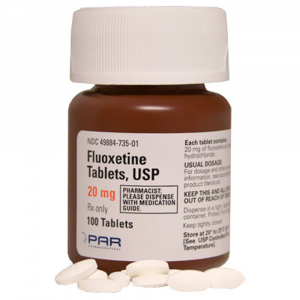What is Fluoxetine for dogs?

Fluoxetine is the generic for Prozac and is a selective serotonin reuptake inhibitor (SSR1) that is commonly used in humans for depression and anxiety.
In 2007, the FDA approved Reconcile (fluoxetine made by Elanco) for use in dogs with separation anxiety in conjunction with behavior modification.
That said, Reconcile is much more expensive than its generic Fluoxetine. It is often prescribed for anxiety, aggression, and behavioral issues in both humans and dogs. There are numerous side effects to this medication. Additionally, fluoxetine does not work on some dogs on its own and will take up to 3 – 4 weeks before affecting behavior in others.
Drug treatment for almost any behavioral change is most useful when combined with regular exercise and behavioral modification. In recent years, fluoxetine hydrochloride has become popular in treating a variety of behavioral problems in dogs like anxiety, compulsive disorders, and aggression.
How does the drug work?

Delaying serotonin re-absorption
A recent study published in Veterinary Practice News by Dr. Nick Dodman, Professor at Cummings School of Veterinary Medicine at Tufts University and Founder of Tufts’ Animal Behavior Clinic, explains that Fluoxetine works by delaying the re-absorption of serotonin into the presynaptic nerve endings following its release by blocking the uptake mechanism.
Effects on 5-HT2C and sigma-1 receptors
“Two other actions of fluoxetine, as opposed to other SSRIs, are that it is a potent 5-HT2C antagonist and a sigma-1 receptor agonist. Over activity of 5-HT2C contributes to anxiety and depression so antagonism of these receptors may be advantageous. The sigma receptor agonist action may also be beneficial in some instances in producing antidepressant-like effects.
Purported neurogenesis stimulant
Another purported action of fluoxetine and other SSRIs is to stimulate neurogenesis (maturation of progenitor neurons) in the dentate gyrus of the hippocampus. In this way, SSRIs may act like Miracle-Gro for the brain. This effect takes time and may be responsible for the longish delay before SSRIs attain their peak effects.
The newly formed neurons may then migrate and populate other brain regions, perhaps increasing memory and other brain functions. So significant is this effect, that when mice had their hippocampi irradiated to prevent neurogenesis, fluoxetine lost its behavioral effect.
Whatever its mechanism, fluoxetine has been shown to be beneficial in a wide range of behavioral issues. I tell students that if they decide to use any behavior modifying medication, fluoxetine’s the one to choose.
Speaking with a Harvard Medical School-based psychiatrist colleague recently, I asked for ratification of something I had been told—that fluoxetine and other SSRIs accounted for 85 percent of psychiatric prescriptions made, whatever the diagnosis,” explains Dr. Nicholas Dodman, BVMS, Dipl. ACVB via Veterinary Practice News.
Things to consider beforehand

With our furry best friends no magic bullet will quickly cure any behavioral problem. There are limitations to the use of medications which may include the following:
- adverse effects
- cost
- limited information on the medication use
- possibility of a lengthy treatment plan before the medication works
- chance that the behavior will manifest again once the medication is withdrawn.
Most antidepressant and anti-anxiety medications used in dogs are well tolerated. But mild reactions include:
- vomiting
- reduced appetite
- diarrhea
- lethargy (only in the first week of use)
- other gastrointestinal problems.
But also some severe adverse effects, such as:
- fatal inflammation of the liver
- seizures
- other signs of toxicity
It is essential to keep in mind that using this type of medication on dogs, without combining it with behavior modification or environmental changes, may allow for the unwanted behavior to return when the drug is withdrawn.
Most of these drugs will require use for a year or even longer. Additionally, although the medication has the potential to help with an array of behavioral problems including thunderstorm phobias and lick granulomas, pet parents need to first assess whether the symptoms their dog is presenting is instead health related.
Benefits of Fluoxetine in dogs

Fluoxetine won’t be prescribed for any old minor symptom. After careful assessment and serious thought of your pet, the vet might write them a prescription. Because, there are issues that this med will prove hugely beneficial for.
Behavioral changes
Common behavior problems in dogs are also related to:
- aggression
- dominance
- impulse control
- and fear.
Dogs are so incredibly social and need to be around other dogs and people. An aggressive dog is hard to deal with and should be introduced to behavior modification therapy.
Separation anxiety
Separation anxiety is when a dog has a panic attack when left alone. The dog has intense anxiety and may bark excessively, destroy furniture, or relieve himself inside the house.
Symptoms are the most intense 15-25 minutes after the pet’s owner has departed. Fluoxetine combined with behavioral therapy has been shown to help with separation anxiety.
OCD
With compulsive disorders, these behaviors are repetitive ones that occur outside of a dog’s usual character, such as incessant licking. The study explains that the anti-compulsive effects of fluoxetine have been clearly documented since the early 1990s.
It may also help for other canine compulsions such as:
- tail chasing
- flank sucking
- blanket sucking
- and light chasing.
Phobias
Fear phobias are intense with physical symptoms like withdrawal and avoidance when there is no aggression.
Shaking and avoidance are both characteristic signs of fear in dogs and often occur during thunderstorms. Fluoxetine might assist in keeping thunderstorm phobias in check by calming your dog.
Melancholy
Any out-of-routine situation in your dog’s life can trigger canine depression. Conditions that may leave your pup feeling uncharacteristically unhappy include:
- a change of environment
- death of a loved one
- kids going back to school after the summer holidays
- a new pet.
Dogs feel sadness just like humans, and Fluoxetine has been shown to help dogs suffering from depression or anxiety.
Related: 10 Tips for Managing Separation Anxiety in Dogs
What to ask your veterinarian

Before prescribing Fluoxetine, your veterinarian will most likely begin discussing treatment options. He or she will recommend and advise you about the specific disorder, and the approved drugs that will be needed to treat the disease.
You will need to thoroughly discuss with your veterinarian any:
- medications
- prescriptions
- over-the-counter
- or herbal that you are giving your dog.
You will also need to inform yourself about how Fluoxetine works, and any possible side effects that this drug may have on your dog.
Most importantly, you will need to prepare yourself in advance should there be any side effects that would require immediate emergency veterinary care. Even if Fluoxetine seems easy enough to use, or you’ve given this to your dog in the past, it’s still important to follow all instructions carefully.
Correct dosages must be administered at all times.
Conditions, including but not limited to, that prevent your dog from receiving Fluoxetine include:
- seizures
- gastrointestinal problems
- pregnancy
- liver disorders
- kidney disease
In these cases, alternative options will be discussed with you.
How to administer Fluoxetine?

Fluoxetine combined with behavioral modification therapy has been developed to provide relief for many anxieties and behavioral problems in dogs. Sometimes giving medications to dogs can be complicated and difficult.
Always follow the exact dosage instructions provided by your veterinarian. This medication can be given with food, so as to prevent stomach sensitivities.
Do not suddenly stop giving this medication without first consulting with your veterinarian. If you miss a dose consult with your veterinarian and never double up on missed doses.
Fluoxetine side effects for dogs
Any medication has side effects, and Fluoxetine is no different. Adverse reactions to these meds include:
- lethargy
- nausea
- vomiting
- shaking
- restlessness
- anxiety
- excessive vocalizations
- panting
- irritability
- it may also, ironically, cause aggressiveness in some dogs.
Allergic reactions
Allergic reactions are also always a possibility, and pet owners should monitor their dogs closely for the following:
- facial Swelling
- hives
- excessive scratching
- onset of Diarrhea
- seizures
- shock
- vomiting
- coma.
Drug interactions
This drug cannot be used with the following medications:
- Isoniazid
- Oramitraz (an ingredient in some tick collars)
- Mitaban – a treatment for mange
- Selegiline
Consult with your veterinarian if your dog is using a tick collar with Mitabin. All products need to be discontinued for 2- 5 weeks before fluoxetine can be administered safely. It’s best to discuss all medications that your dog is on with your veterinarian before the use of fluoxetine.
Final say on behavior modification in dogs

Fluoxetine, combined with behavior modification therapy, has been developed to provide relief for many anxieties and behavioral problems in dogs.
It is essential to keep in mind that using this type of medication on dogs, without combining it with behavior modification or environmental changes, may allow for the unwanted behavior to return when the drug is withdrawn.
As pet parents, we should always be aware that so many of these behaviors are standard in our dogs, and they will exhibit them at some stages of their lives.
That said, if an unwanted behavior is exhibited too frequently, it’s time to consult with your veterinarian, and possibly opt for some positive dog training classes. Additionally, socialization, the right amount of daily exercise, positive dog training, and regular veterinary care can all work together to create a well-balanced and happy dog.
